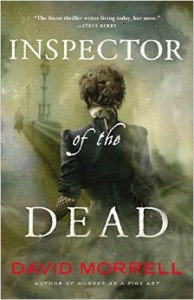For those not familiar with the cast of Murder As A Fine Art, the novel s main protagonist is Thomas De Quincey, a drug addicted Victorian author and essayist mostly known for his autobiographical book, Confessions of an English Opium-Eater. De Quincey has a superior but unappreciated mind when it comes to deduction and reasoning, which he uses to help law enforcement solve murder cases. De Quincey’s twenty-one year old, single daughter Emily, has devoted herself to her father’s care and she seldom leaves his side. In addition, there is the Scotland Yard constable named Becker and a Scotland Yard Detective named Ryan, both holdovers from Murder As A Fine Art who also figure prominently in Inspector Of The Dead.
Inspector Of The Dead, opens with the murder of a prominent older woman in a church. While in full view of the congregation her throat was cut, only no one saw the act or the murderer. In the woman’s possession was a letter implicating the involvement of a once failed assassin and a secret society. We soon learn that the dead woman’s family and staff have also been brutally slain. Soon, other well-to-do families are viciously murdered with similar letters left at the scene. All of these letters point to an eventual attempt on the Queen’s life. What follows is painstaking sleuthing amidst the richest and poorest denizens of Victorian London as well as its famous and infamous, all against the backdrop of a losing war.
Inspector Of The Dead is captivating from its first sentence to its last. One of the reasons for this is the amount of research Morrell has weaved into his plotting. From the minutiae of London dwellings to his descriptions of the politics and the battle scenes during the Crimean War, there is a realism to the text that leaves you breathless or at very least in awe. Readers can’t help but feel they are walking the crowded and sometimes filthy streets of Victorian London.
Morrell changes the point of view in the narrative often in Inspector Of The Dead, switching it from a male to female P.O. V., from the antagonist to the protagonist, and from the present to flashbacks. By doing so the author not only adds tension to the plot but he keeps the readers involved, so much so that we continuingly shift our opinions on who the murderer may be. Which brings me to another point—the P.O.V. of De Quincey is in short supply in Inspector Of the Dead. It feels odd that the principle character in the series is regulated to a supporting role, but I will say this is more than made up by the involvement of the reoccurring characters, Emily’s journal entries, and most surprisingly, the thoughts of the antagonist.
Inspector Of The Dead is a fascinating look at the violent underbelly of Victorian London. The characters all ring true, the action is plentiful and often brutal, and the plot feels as fresh as it is exciting. David Morrell is no stranger to the bestseller list (First Blood, The League Of Night And Fog, The Brotherhood Of The Rose, Creepers, and many more) and Inspector Of The Dead will certainly debut high when it is released.
- The Bone Mother – Book Review - December 6, 2017
- Journalstone October Newsletter - October 13, 2017
- July Journalstone Newsletter - July 19, 2017
- The Belko Experiment – Movie Review - July 14, 2017
- April Journalstone Newsletter - April 11, 2017
- The Demolisher – Movie Review - January 24, 2017
- Agatha – Movie Review - January 20, 2017
- November JournalStone Newsletter - November 4, 2016
- Enter to Win Tickets to See ‘From Dusk Till Dawn’ — Back in Theatres for Two Days Only! - October 25, 2016
- Help Celebrate the Release of ‘Freaks Anon’ – Enter to Win a Signed Copy! - October 10, 2016



